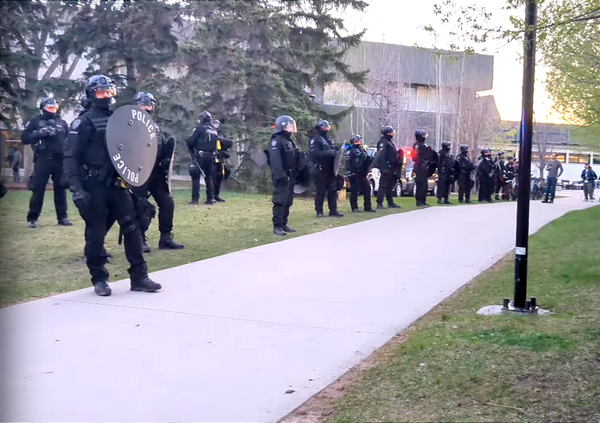Alberta virtual prescribing is carceral care: Part 1
Police are connecting people in detainment with opioid agonist treatments. How does this interfere with prescriber-patient relationships?

Drug Data Decoded has recently discussed how police crackdowns are being rolled out in Calgary and Edmonton in a presumed effort by the UCP government to disappear unhoused people in the run-up to the election. The suspicions these strategies raised about expanding police powers to force people into abstinence were confirmed this week by Alanna Smith, writing for the Globe & Mail.
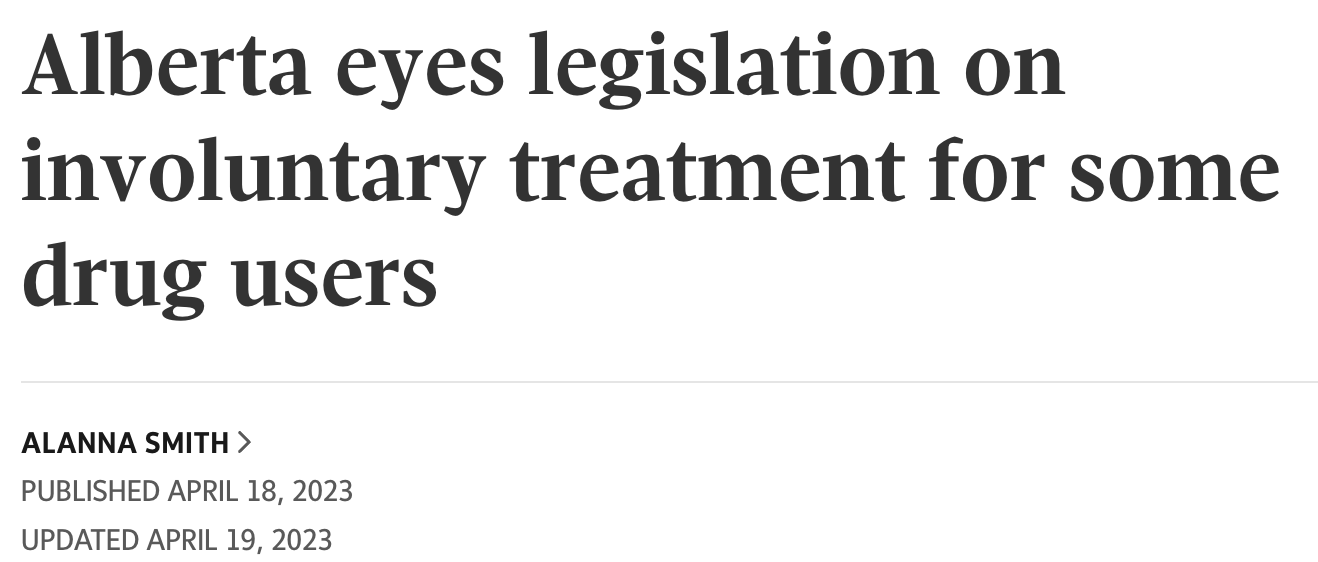
A largely unspoken aspect of this revelation is the late-2021 legislation expanding police powers to ‘offer’ access to the Virtual Opioid Dependency Program (VODP) for people detained by police. According to Minister of Public Safety Mike Ellis,
"We cannot simply remove our law enforcement officers from the equation. A comprehensive system of care can and must involve our law enforcement officers in the solution.”
The VODP is, effectively, telehealth that facilitates prescribing of opioid agonist treatments like methadone, Suboxone and Sublocade. Overseen by Dr. Nathaniel Day for the last few years, the VODP was initially geared to improving rural access — especially critical as rural primary care was decimated under the UCP. But the UCP recognized its potential for centralizing control in carceral prescribing — and, apparently, for coercing people into treatment when they’re held in custody.
The abstinence hierarchy
With abstinence being the stated goal of the UCP’s recovery-oriented system of care, we can expect prescribing to fall in line. At the moment in Alberta, we can track prescribing within the Opioid Dependency Program (of which the VODP is one branch). Oral morphine (Kadian) prescribing is widespread but oddly, not tracked by the system, and though diacetylmorphine (heroin) and fentanyl were promised under supervision in October 2022, they have yet to show up.
The graphic below suggests a hierarchy of abstinence orientation in opioid prescribing based on opioid strength, potential for sharing (pill > patch > liquid = subcutaneous injection), and presence of antagonists such as naloxone that block opioid receptors and minimize euphoria, pain relief and other positive sensations associated with opioids.

Hypothesis: (1) Prescribing trends of these drugs have matched the UCP’s abstinence orientation since they took power. (2) Expanded police power to offer virtual treatment to people in custody since December 2021 helps support this abstinence orientation.
The prescribing reality
The Government of Alberta’s Substance Use Surveillance System (ASUSS) provides data on prescribing that can help us understand the government’s moral compass. In order of most to least abstinence-oriented, let’s examine the data for each prescribed opioid medication in the system. Note: Kadian (oral morphine) data are not available in the system.
Suboxone
An orally administered blend of opioid agonist buprenorphine with antagonist naloxone, Suboxone is sold by Indivior. As Crackdown eloquently describes it, blending an opioid antagonist in with your opioid is like having a Cop Baked In to your drug supply. You can imagine why many people used to opioids like hydromorphone or fentanyl report feeling sick when using Suboxone.
Suboxone was already on a steep rise when the UCP came to power in 2019. Amid the VODP expansion into police custody in December 2021, Suboxone prescribing rose sharply.
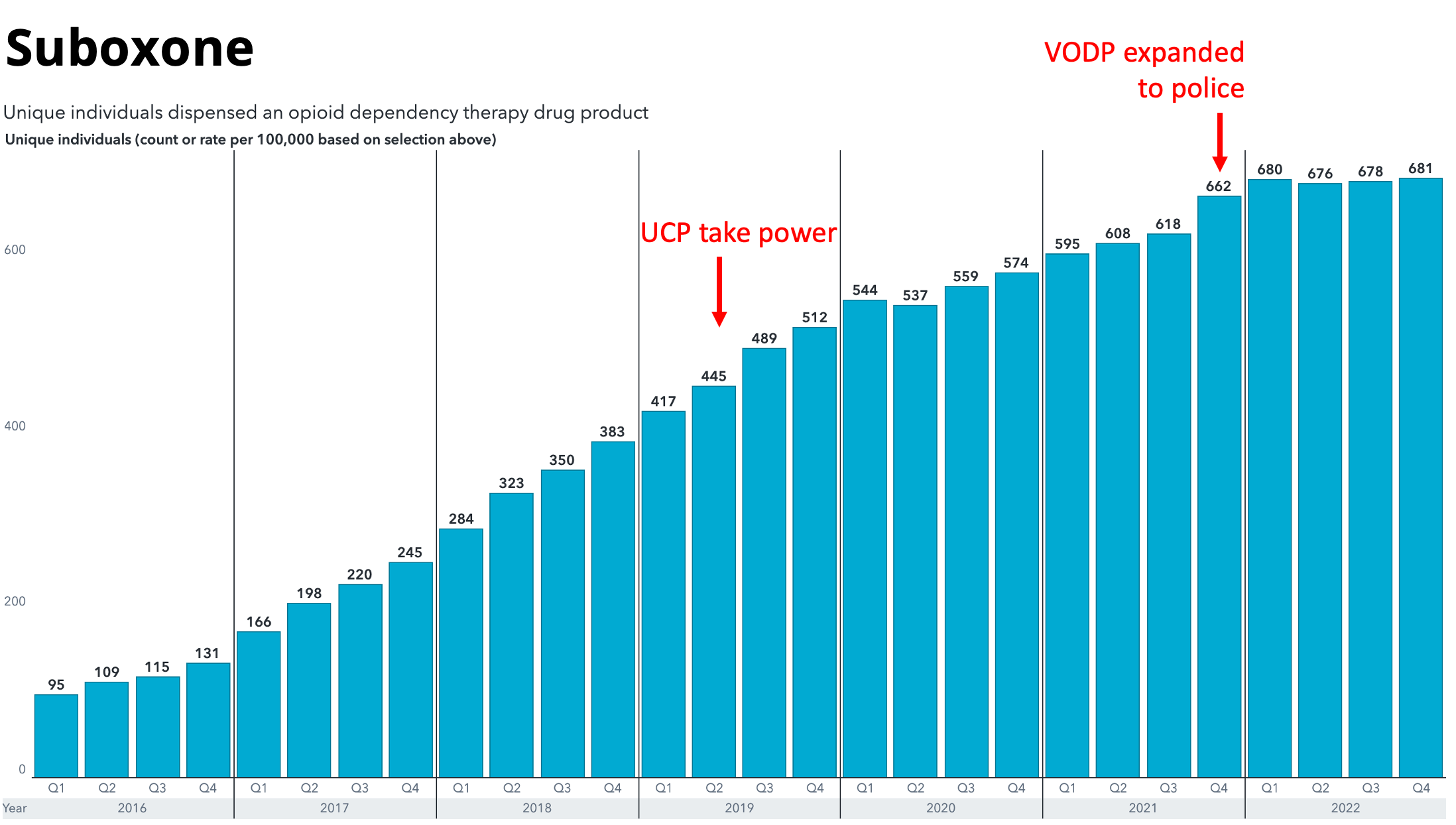
Sublocade
Sublocade is typically administered as a subcutaneous buprenorphine injection that lasts a month or so and provides a slow-release effect. It was largely unused until the VODP expansion into police custody in the fourth quarter of 2021. It is sold by Indivior, the same company that makes Suboxone, which has undertaken extensive lobbying in Alberta from summer of 2020 to 2023. Sublocade’s coverage in Alberta is now about 15% that of Suboxone.
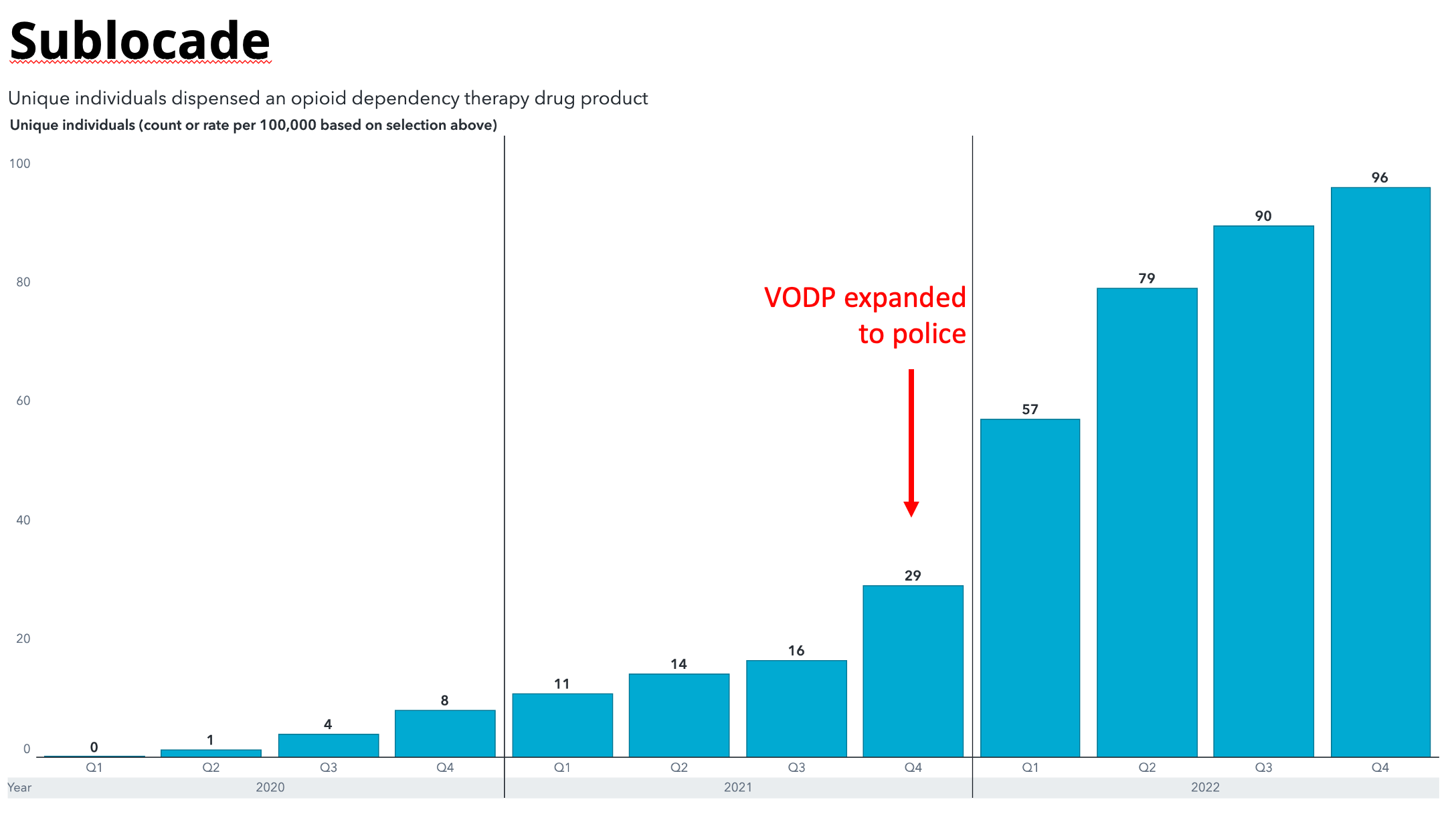
Methadone
Available and increasingly widespread since the 1960s, methadone was also on a steady rise when the UCP took power in 2019. However, as the VODP expansion to police custody approached in 2021, methadone dispensing hit its first decline in years.
This decline appears unrelated to the abrupt closure of Levitee Clinics across Alberta, which began in July 2022. Methadone now has around 60% of the reach of Suboxone. It is taken orally.
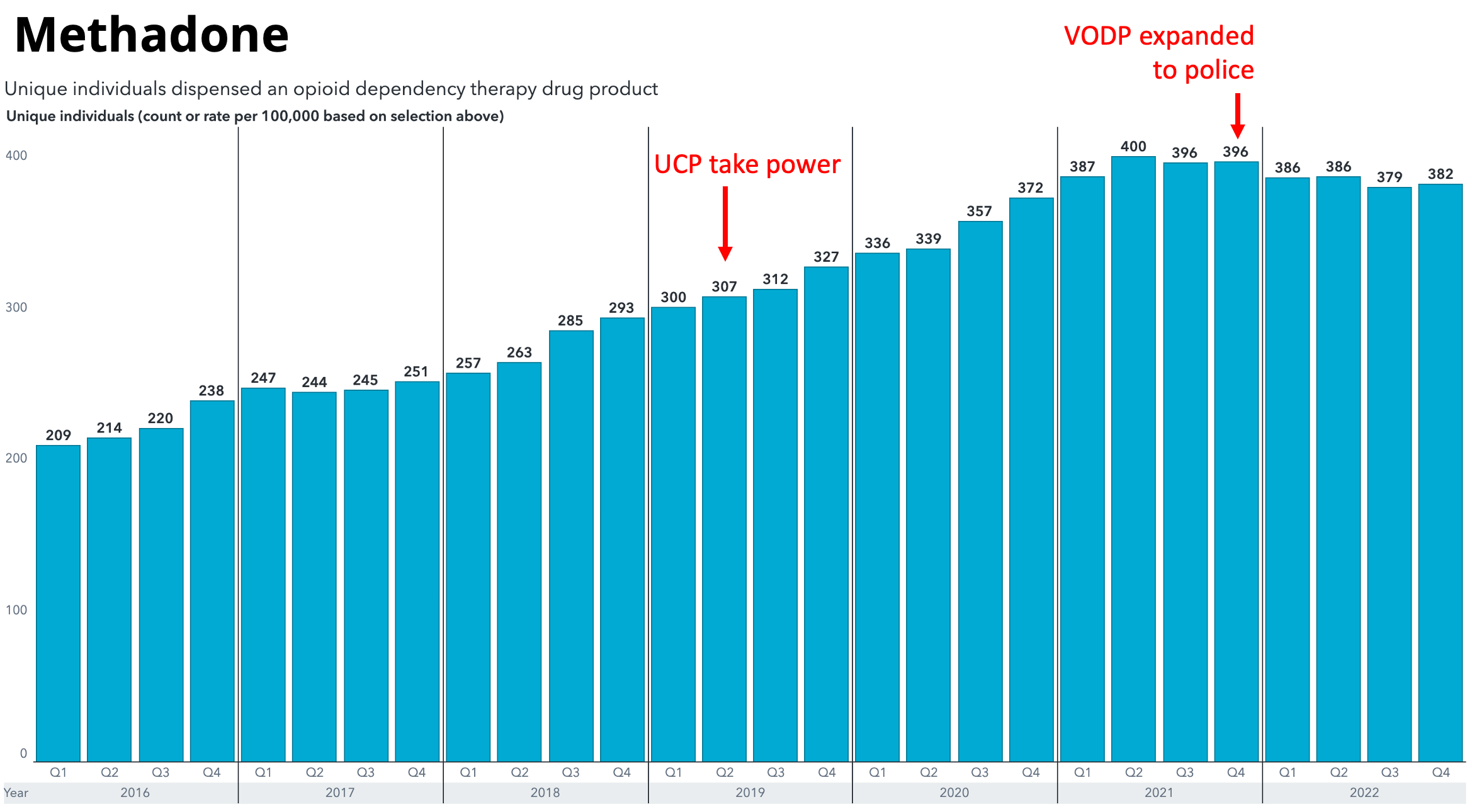
Hydromorphone
The subject of greatest controversy among these medicines, hydromorphone or Dilaudid was on the rise under the highly successful injectable opioid agonist treatment (iOAT) program initiated by the NDP. However, it entered a tumultuous era after the UCP took power.
Under the new Narcotics Transition Services program announced by the UCP in October, people could no longer carry hydromorphone outside of centralized clinics. While Ophelia Black recently won her court injunction against the Alberta Government to protect her access to take-home carries, this win by lawyer Avnish Nanda does not extend to others in the province. There are now only 17 people per 100,000 with access to this medicine, which is intended as an oral medication but can be injected.
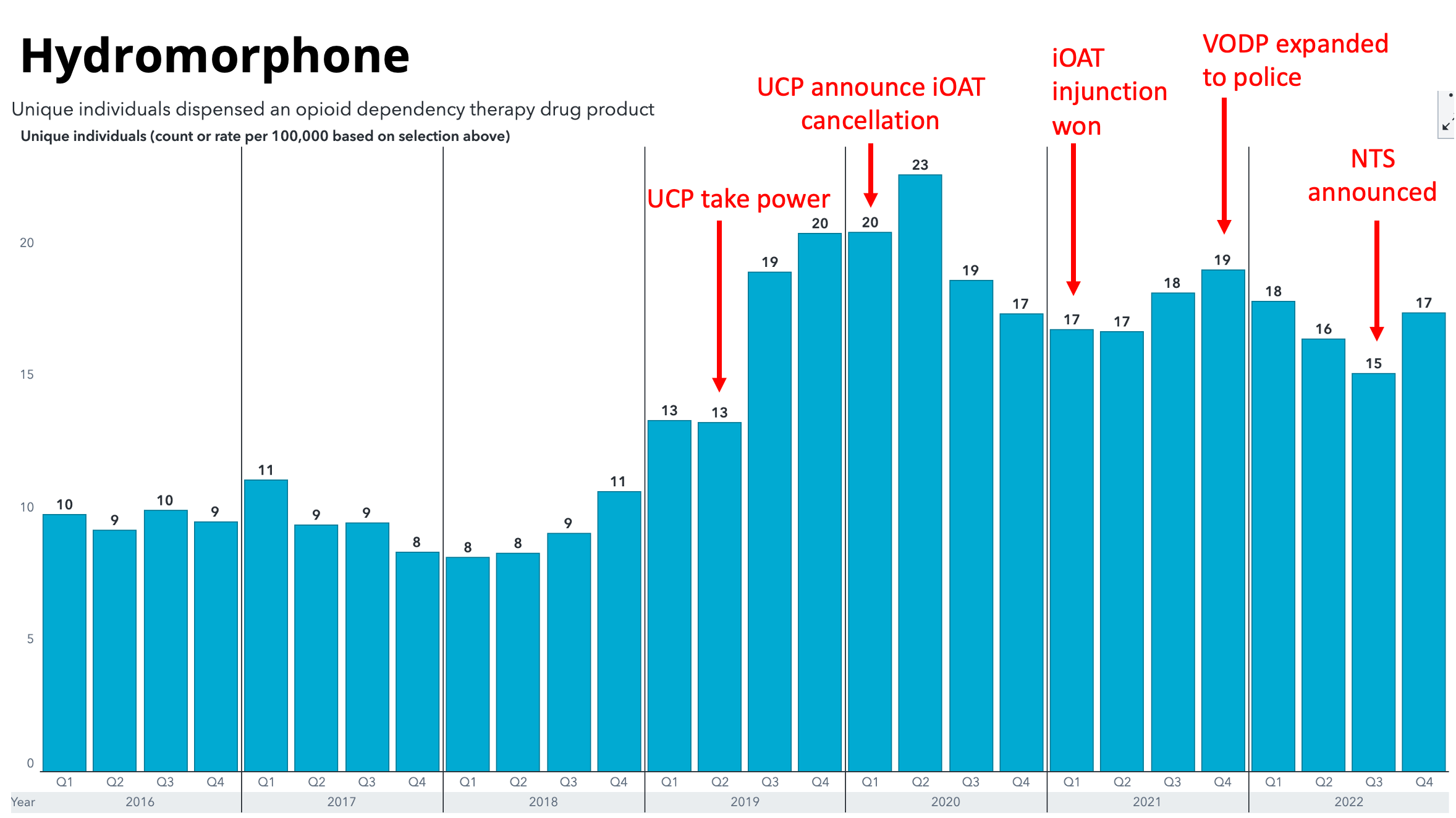
Hypothesis, revisited
Let’s reexamine the earlier hypotheses, that (1) Prescribing trends of these drugs have matched the UCP’s abstinence orientation since they took power and (2) Expanded police power to offer virtual treatment to people in custody since December 2021 helps support this abstinence orientation.
The only two medicines with access currently being expanded are Suboxone and, even more so, Sublocade. Meanwhile, methadone and hydromorphone prescribing have stagnated or declined. All of this is another way of saying people who aren’t currently seeking abstinence are having their options narrowed considerably.
These prescribing trends also appear to match the expansion of the Virtual Opioid Dependency Program into police custody in late 2021, which could indicate that people are being coerced into using some medications but not others while being held in custody.
What does this mean for health care providers trying to look after their patients? We’ll discuss that in Part 2.
With Twitter suppressing Substack links, I need whatever help you can give to get this work to a broader audience: please consider subscribing and sharing with friends!



